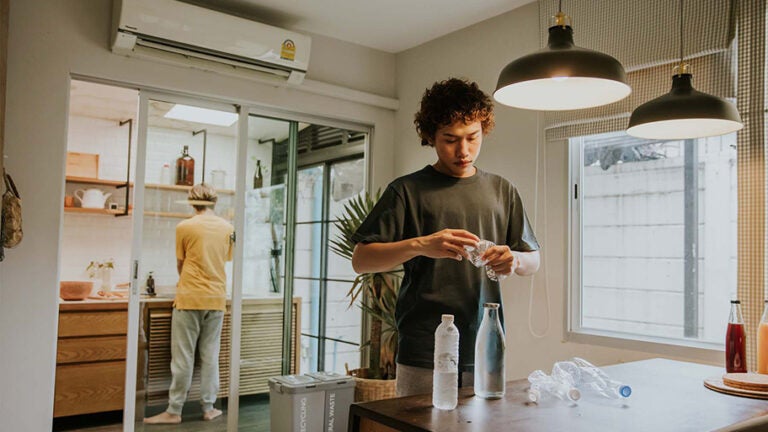
Sustainable shelter: How these USC experts are living green at home
Whether one rents or owns, some eco-conscious solutions remain accessible to anyone willing to blend intentionality, awareness and pinches of sacrifice to support the planet.
On the West Coast in particular, water earns substantial attention — and for good reason. Much of California faces severe drought conditions, and federal authorities have issued troubling outlooks for the Colorado River, a main source of fresh drinking water for Californians.
To spur water conservation, California Water Service (Cal Water), the state’s largest water utility, provides single-family residential customers free kits packed with water-saving tools, such as high-efficiency showerheads, faucet aerators and leak-detection dye tablets.
On the energy front, Wändi Bruine de Bruin, Provost Professor of Public Policy at the USC Price School of Public Policy and the Department of Psychology at the USC Dornsife College of Letters, Arts and Sciences, said residents bickering about who left the kitchen lights on should instead direct their attention to a bigger energy-sucking culprit: home heating and air conditioning.
Residents can reduce heating and cooling loads by closing blinds and curtains during hot days and opening windows for natural ventilation during cool nights. While such measures require residents to recalibrate their expectations of the constant 72-degree home, the changes cost nothing and, in fact, generate savings.
Other energy-saving practices include using cold water for laundry, swapping the dryer for a clothesline or drying rack and turning off devices when not in use, especially since “phantom energy” can account for up to 20% of a home’s monthly energy usage.
“We can all make choices every day to improve the sustainability of our homes,” Bruine de Bruin said.
Taking the next steps toward living sustainably
To further reduce water use, homeowners might lean into drought-tolerant landscaping and native plants. The Turf Replacement Program from the Los Angeles Department of Water and Power offers a rebate of $3 per square foot to homeowners replacing grass with a sustainable landscape, which also lowers water bills.
Inside the home, Bhavna Sharma, an assistant professor at the USC School of Architecture, urged residents to conduct online assessments to inventory their home’s water consumption and identify potential improvements. LADWP offers “how-to” videos for water audits and leak checks. Rebate programs like Cal Water’s $100 rebate on high-efficiency toilets can trim the expense of purchasing new fixtures or appliances.
Many utilities, including LADWP and SoCalGas, offer home energy improvement assessments to propel resource-minded energy usage. In some cases, the utilities even install energy-saving devices free of charge.
While switching to more energy-efficient LED lightbulbs and installing a smart thermostat are undoubtedly worthwhile ventures, routine home maintenance is critical. Annual service of heating and air conditioning units and regularly changing air filters helps the home’s mechanicals operate at peak efficiency. Sealing cracks around doors and windows, meanwhile, reduces drafts and cold spots, enhancing comfort and saving energy.
Readying for bigger leaps to sustainability at home
Homeowners with the means to retrofit their homes might install energy-efficient windows or upgrade home insulation. A thermographic inspection will identify insulation needs, while certain public programs defray costs. The U.S. Department of Energy, which hosts various rebate programs designed to spur energy-efficient living, offers a 10% tax credit up to $500 on qualified insulation purchases.
In California, one of the best places in the world to harness sunlight for electrical power, solar electricity continues gaining mainstream attention. Though converting to solar power requires a substantial investment, some existing feed-in tariffs — which provide homeowners a guaranteed price for the energy they deliver to the grid — and financing plans alleviate the hefty cost of installing solar power, said Josh West, professor of Earth sciences and environmental studies at USC Dornsife.
Among the many cost-reducing programs for solar-powered products are the $3,500-$4,500 rebate SoCalGas offers its customers purchasing an Energy Star-certified solar thermal system with a gas water heater backup.
“These one-time decisions require a significant investment, but then you don’t have to think about them again,” Bruine de Bruin said.